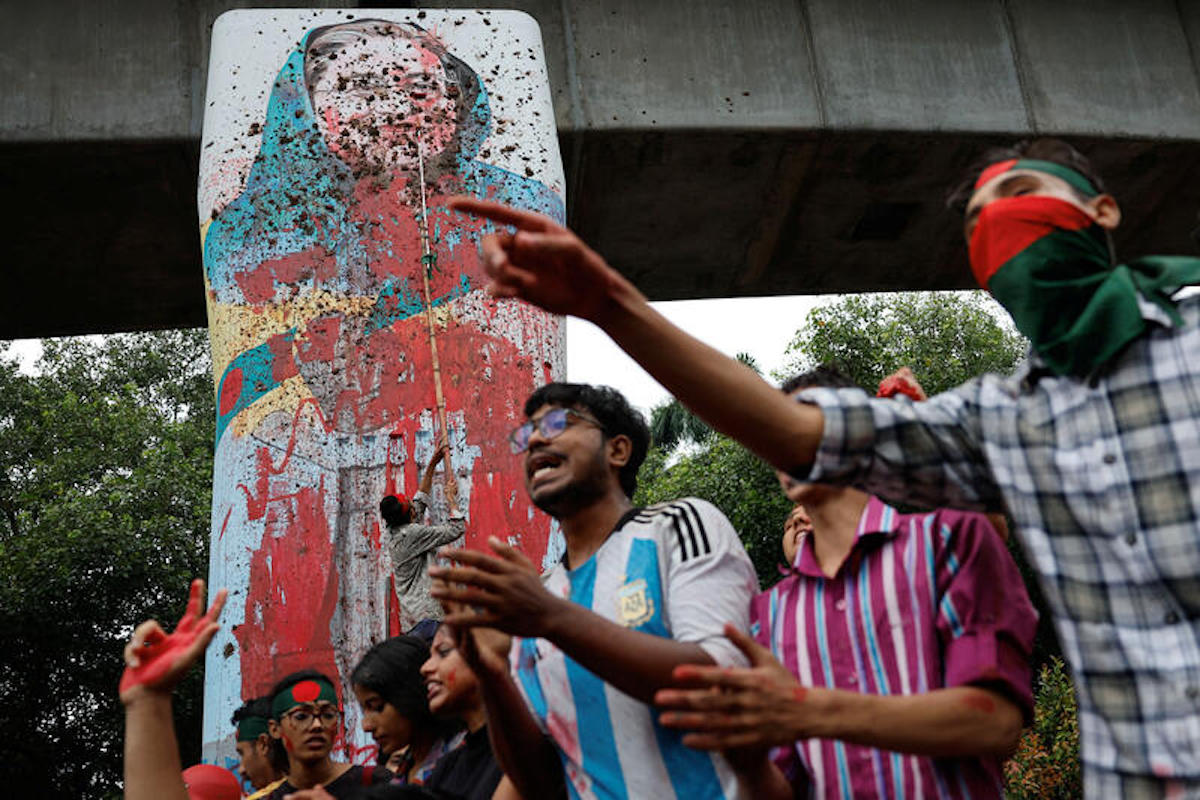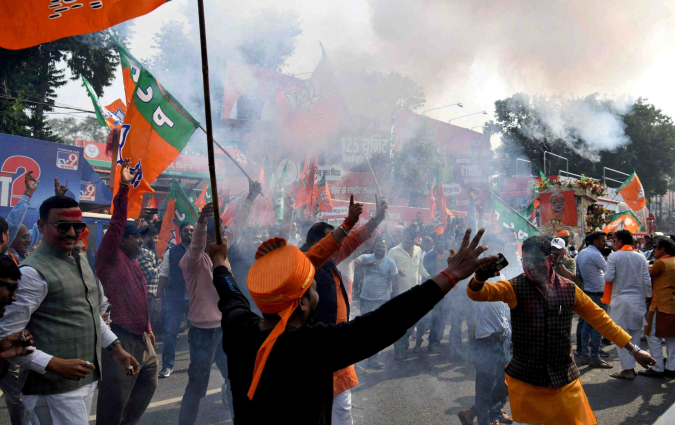From self-censorship to documenting repression: news media’s role in the protests toppling Bangladesh’s PM

Protesters shout slogans as they vandalise a mural of Bangladeshi Prime Minister Sheikh Hasina in Dhaka on 3 August 2024. | REUTERS/Mohammad Ponir Hossain
On 4 August thousands of protesters gathered in Dhaka, obstructing traffic as a form of civil disobedience to demand the resignation of Bangladesh Prime Minister Sheikh Hasina. At least 100 people were killed. Protestors had initially taken to the streets to oppose quotas in government jobs, but they soon showed their discontent against rising corruption, democratic backsliding and economic inequality.
On 5 August Hasina resigned and fled the country with her sister on a helicopter for neighbouring India. An interim government was formed under the leadership of economist and Nobel Prize laureate Muhammad Yunus.
I spoke to Bangladeshi academic Dr. Mubashar Hasan to know more about the situation of Bangladesh’s news media under Sheikh Hasina’s rule and the challenges of journalism in the country going forward.

Hasan is a postdoctoral fellow at the University of Oslo, and the author of two books on the country. His research focuses on authoritarianism, freedom of expression and human rights in Bangladesh.
Before joining academia, Hasan worked as a freelance journalist for The New Humanitarian and was shortlisted for a global media award for this investigative news story on human trafficking. For a while he worked as a communications officer at Oxfam and taught media and journalism in the University of Liberal Arts in Bangladesh. Our conversation has been abridged for clarity and length.
Q. In the past decade and a half, Bangladesh has seen a dramatic growth in the media sector. And yet it ranks 165th out of 180 countries in RSF’s Press Freedom Index. Both trends can seem contradictory to an outside observer. How would you explain them?
A. In order to understand these trends, you have to understand that politics in Bangladesh is very partisan and journalists are involved in this.
Let’s go back to the time when Sheikh Hasina started her stint as the Prime Minister in 2008. Even in the media, there were journalists who were the supporters of the Bangladesh Awami League, often simply called the Awami League, which is Sheikh Hasina’s party. They were supporting her party mainly because her father, Sheikh Mujibur Rahman, played an outsized role during the 1971 war. [In 1947, the Indian subcontinent was partitioned on the basis of religion. The Muslims of north west India were grouped into West Pakistan while those of the east became a part of East Pakistan. In 1971, East Pakistan fought a war of liberation with the help of India and is now known as Bangladesh].
After Bangladesh came into being and Sheikh Mujib formed his government, he became unpopular. In 1975, he and some members of his family were killed in an army coup. There is a group of journalists who are still very emotional about this period and they became highly supportive of the Awami League.
Q. What happened when Sheikh Hasina came into power?
A. Right after 2008, a domestic war crimes tribunal was set up in Bangladesh to investigate and prosecute suspects for the violence committed in 1971 by the Pakistan Army and their local collaborators, also called “razakars.” The trial was highly flawed and was criticised by human rights organisations. They concluded that the Awami League was involved in a political vendetta rather than ensuring justice for the victims of the 1971 war.
At that time, there was so much polarisation in Bangladeshi media that those questioning that trial were called “razakars.” I have never seen that level of media support for the government as I saw during that time.
Shortly after the trial, big companies close to Hasina began to own media houses, and that is how pro-government propaganda became institutionalised.
A few independent news organisations were born and tried to resist political pressure while producing some sort of objective news. Examples are the Bengali daily The Daily Prothom Alo, the largest circulated newspaper in the country, and to some extent the Daily Star. This means that you could have a lot of media, but not enough objective news.
Q. What did the government do about independent news outlets?
A. In order to curb these independent voices, an oppressive law called the Digital Security Act was adopted in 2018. The law allows police officers to detain people without any arrest warrant. [As this piece explains, dissenters were allegedly tortured and arrested for social media posts, and they had minimal judicial recourse. Since the provisions of the law were vague, the government got to decide which online content was objectionable.]
The country also saw extrajudicial killings and forced disappearances, media ownership was strongly tied with the ruling party, and the government passed a few punitive laws. All of this created a culture of fear in the news media.
At the University of Oslo and in collaboration with scholars at University of Nevada, we did a survey study in 2020 where we found self-censorship to be prevalent across the board amongst journalists working in Bangladeshi media. Journalists adopted self-censorship to keep their jobs and themselves safe.
This gave rise to a few local media collaborations with international news organisations, and the rise of diaspora media like Netra News, which publishes a lot of critical investigative stories.
Q. Bangladesh’s economic growth has been widely reported by international news organisations. It is also related to the protests that led to Sheikh Hasina’s resignation. Why?
A. Economic growth doesn't necessarily mean equitable growth. We need to acknowledge the flaws in Bangladesh’s growth-centred model. The country is at the bottom of the corruption perception index and at the bottom of the rule of law index too. The independence of its judiciary is under question and the establishment is highly corrupt and has authoritarian tendencies.
If you consider those factors, then questions on economic data become easier to raise because that data is always given by the government. It’s easy to see this economic growth story as political propaganda spearheaded by the Bangladeshi government in order to mask serious human rights violations.
Q. What’s the role of the media in this controversy?
A. Bangladesh’s growth story is mostly not told by Bangladeshis. The experts talking about it are non-Bangladeshis. This is an interesting use of the media and is the only way the government can sustain their mode of governance. In Bangladesh, the development story mostly came from the government or those in power. Development was a good public relations project.
Publications from outside the country reported on the growth story, using sources who did not necessarily have their ear to the ground. Not many Bangladeshi independent writers wrote about this. In 2023 the government banned the books of two Bangladeshi writers because they raised questions on the country’s economic growth.
Q. Could you give me an example of how the mainstream media in Bangladesh bowed down to the powers that be?
A. The Prime Minister’s press conferences are a great example. It was an utmost unprofessional exercise. Journalists would ask leading questions. Before the 2018 elections, one journalist asked Hasina, “What magic will you show once you come into power?”
During the student protests, they asked leading questions too. You need to understand that the protests caught fire after Sheikh Hasina referred to the protesting students as “razakars”. That was in response to a question from a journalist who asked who should get jobs: children of freedom fighters or children of razakars. Hasina then called the protestors “razakars.”
Q. What was the role of the news media during the recent protests?
A. There were broadly three phases of the protests and in each of those phases the media played different roles.
In the first phase, the protestors wanted a reform in the quota system in public service jobs. At some point, unarmed students were killed in police violence. The reason why the student protests were so resilient was because people were able to record these atrocities and publish them on social media in real time. Some mainstream media were covering the protests objectively. Others were terming the protestors Islamist and terrorist.
In the second phase, the Awami League’s student wing participated in the violence using firearms and machetes alongside the police. They were not state forces, but they enjoyed impunity while attacking the protesting students, so they started to fight back. At this point, the media did a great job in documenting government repression through photos, documents and videos.
Hasina called the Editors Guild and asked if they could cover the protests favouring her supporters. Some senior journalists agreed, and this made protesters angry with some sections of the media. At some point the state-owned television station was set on fire.
The Prime Minister imposed an internet shutdown, along with a shoot-to-kill policy. This meant that no news came out from the ground easily. The only sources of information were diaspora media like Netra News.
Only AFP had a particular wifi network that was operational despite an internet shutdown in Dhaka. All the other news agencies started to use their wifi network. Foreign news organisations like DW and Al Jazeera played a very important role. Foreign media like Reuters broke the news that Bangladesh’s army had used UN logos to attack the protesters, and that is when the UN began putting pressure on the army to rein it in.
The third phase of the protests came when the internet was restored. By then, the only point of the agenda was that Hasina should resign. At this stage, the media came out all guns blazing and they did a good job.
Q. How do you imagine the news media to operate under the interim government of Dr Muhammad Yunus?
A. They would enjoy more freedoms. Yunus is widely respected. In his advisory board, there are people who are human rights defenders, torture survivors and activists with integrity. They all understand the importance of democracy and free media even though they don't have a mandate from the public.
In every email we send you'll find original reporting, evidence-based insights, online seminars and readings curated from 100s of sources - all in 5 minutes.
- Twice a week
- More than 20,000 people receive it
- Unsubscribe any time
signup block
In every email we send you'll find original reporting, evidence-based insights, online seminars and readings curated from 100s of sources - all in 5 minutes.
- Twice a week
- More than 20,000 people receive it
- Unsubscribe any time







